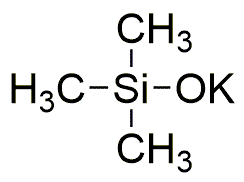Potassium trimethylsilanolate is widely utilized in research focused on:
- Silicone Production: This compound serves as a key precursor in the synthesis of silicone polymers, which are used in various applications from sealants to medical devices.
- Surface Modification: It is employed to modify surfaces of materials, enhancing hydrophobic properties, which is particularly beneficial in coatings and textiles.
- Catalysis: In organic synthesis, it acts as a catalyst in reactions, improving efficiency and yield, making it valuable in pharmaceutical and fine chemical industries.
- Adhesives and Sealants: The compound is used in formulating advanced adhesives that require strong bonding and resistance to environmental factors, ideal for construction and automotive applications.
- Research and Development: It plays a significant role in laboratories for developing new materials and studying silane chemistry, providing researchers with a versatile tool for innovation.
General Information
Properties
Safety and Regulations
Applications
Potassium trimethylsilanolate is widely utilized in research focused on:
- Silicone Production: This compound serves as a key precursor in the synthesis of silicone polymers, which are used in various applications from sealants to medical devices.
- Surface Modification: It is employed to modify surfaces of materials, enhancing hydrophobic properties, which is particularly beneficial in coatings and textiles.
- Catalysis: In organic synthesis, it acts as a catalyst in reactions, improving efficiency and yield, making it valuable in pharmaceutical and fine chemical industries.
- Adhesives and Sealants: The compound is used in formulating advanced adhesives that require strong bonding and resistance to environmental factors, ideal for construction and automotive applications.
- Research and Development: It plays a significant role in laboratories for developing new materials and studying silane chemistry, providing researchers with a versatile tool for innovation.
Documents
Safety Data Sheets (SDS)
The SDS provides comprehensive safety information on handling, storage, and disposal of the product.
Product Specification (PS)
The PS provides a comprehensive breakdown of the product’s properties, including chemical composition, physical state, purity, and storage requirements. It also details acceptable quality ranges and the product's intended applications.
Certificates of Analysis (COA)
Search for Certificates of Analysis (COA) by entering the products Lot Number. Lot and Batch Numbers can be found on a product’s label following the words ‘Lot’ or ‘Batch’.
Numéro de catalogue
Numéro de lot/série
Certificates Of Origin (COO)
This COO confirms the country where the product was manufactured, and also details the materials and components used in it and whether it is derived from natural, synthetic, or other specific sources. This certificate may be required for customs, trade, and regulatory compliance.
Numéro de catalogue
Numéro de lot/série
Safety Data Sheets (SDS)
The SDS provides comprehensive safety information on handling, storage, and disposal of the product.
DownloadProduct Specification (PS)
The PS provides a comprehensive breakdown of the product’s properties, including chemical composition, physical state, purity, and storage requirements. It also details acceptable quality ranges and the product's intended applications.
DownloadCertificates of Analysis (COA)
Search for Certificates of Analysis (COA) by entering the products Lot Number. Lot and Batch Numbers can be found on a product’s label following the words ‘Lot’ or ‘Batch’.
Numéro de catalogue
Numéro de lot/série
Certificates Of Origin (COO)
This COO confirms the country where the product was manufactured, and also details the materials and components used in it and whether it is derived from natural, synthetic, or other specific sources. This certificate may be required for customs, trade, and regulatory compliance.


